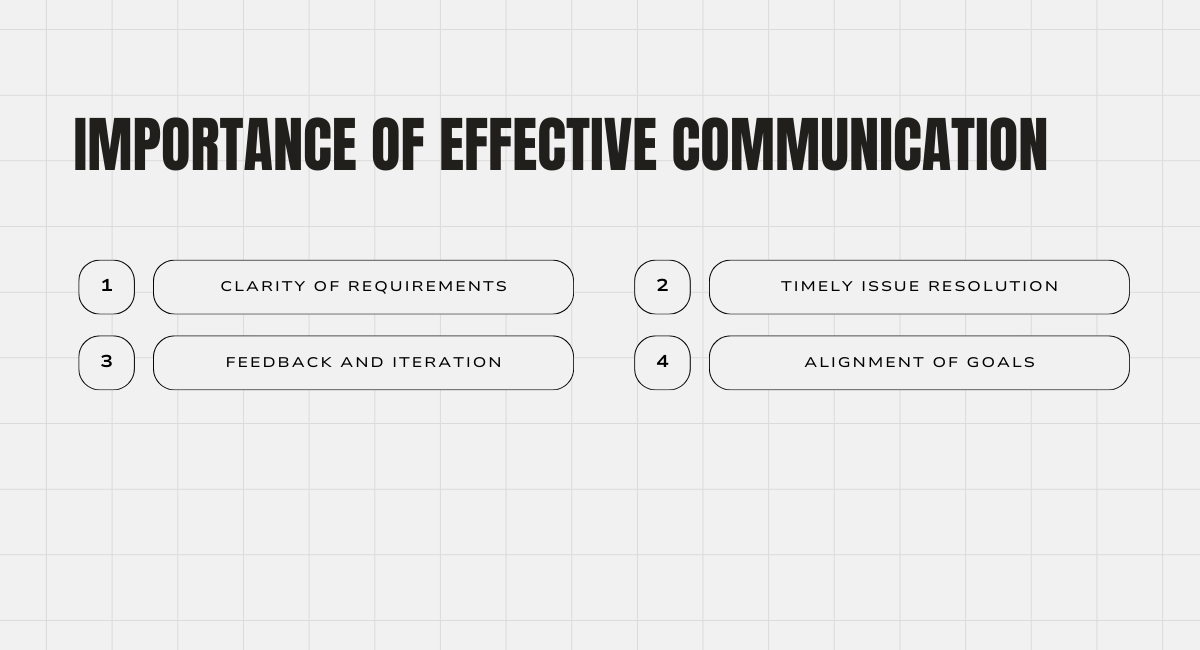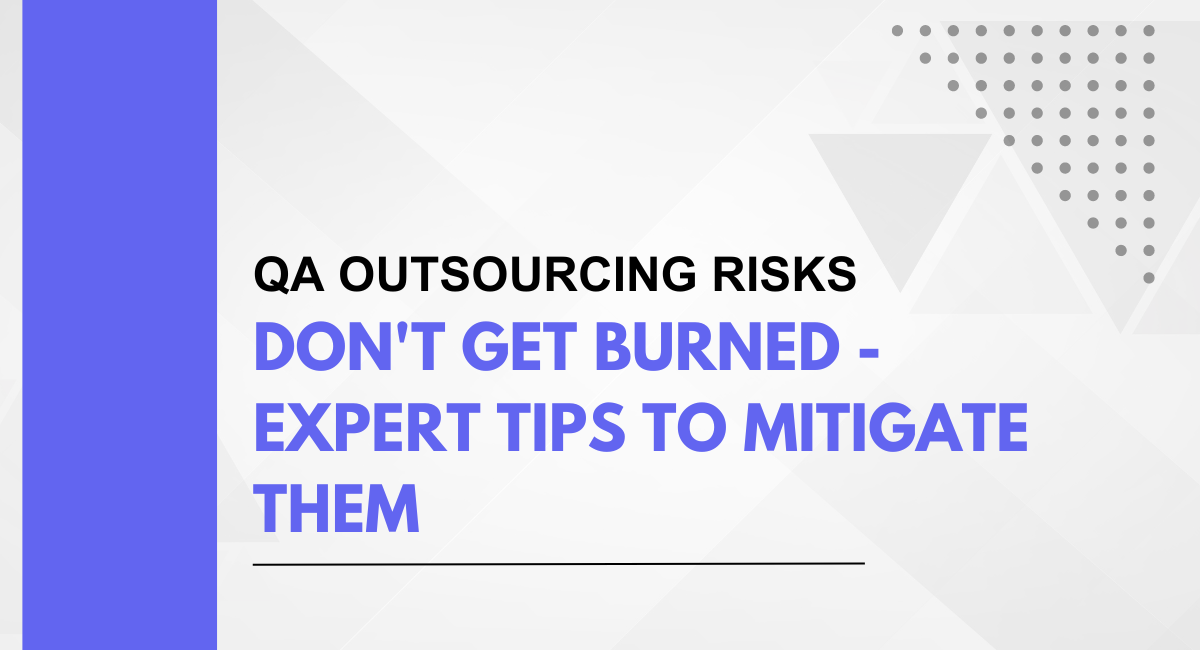Quality Assurance (QA) is a systematic process that ensures software meets specified requirements and operates without errors. It involves a series of activities throughout the software development life cycle to verify and validate that the end product meets the desired quality standards. QA outsourcing is the practice of delegating QA activities to external service providers or specialized QA teams. This approach allows organizations to leverage the expertise of QA professionals without maintaining an in-house QA department.
Outsourcing QA services can encompass various activities, such as test planning, test case design, test execution, performance testing, and more. The outsourcing model provides flexibility, scalability, and cost-effectiveness, enabling organizations to focus on their core competencies while ensuring that their software meets the highest quality standards.
Common QA Outsourcing Risks
QA outsourcing can bring numerous benefits to an organization, but it is not without its challenges. One of the most critical factors influencing the success of QA outsourcing is communication. This section explores the importance of effective communication in QA outsourcing and the risks associated with poor communication.
A. Lack of Communication
Effective communication is a cornerstone of successful QA outsourcing. It involves the clear and transparent exchange of information between the client and the outsourcing partner. This communication extends beyond project specifications and timelines to encompass expectations, feedback, and problem-solving.
Importance of Effective Communication

Effective communication is crucial for the following reasons:
- Clarity of Requirements: Unambiguous communication ensures that both parties have a shared understanding of project requirements, objectives, and expectations.
- Timely Issue Resolution: Prompt communication allows for quick identification and resolution of issues, preventing them from escalating and impacting project timelines.
- Feedback and Iteration: Regular feedback loops facilitate continuous improvement, allowing the outsourcing partner to refine their processes and deliver higher-quality results over time.
- Alignment of Goals: Transparent communication helps align the goals and priorities of both the client and the outsourcing partner, fostering a collaborative and mutually beneficial relationship.
Risks Associated with Poor Communication

- Misunderstandings: Inadequate communication can lead to misunderstandings regarding project requirements, scope, or expectations, resulting in deliverables that do not meet the client's needs.
- Delays: Poor communication can contribute to delays in project timelines, especially when there are uncertainties, unresolved issues, or a lack of clarity on priorities.
- Quality Issues: Without effective communication, the outsourcing partner may not fully grasp the client's quality standards, leading to the delivery of subpar or unacceptable work.
- Increased Costs: Inefficient communication may result in rework, revisions, and additional costs associated with addressing issues that could have been avoided with more transparent communication.
- Strained Relationships: Continuous communication challenges can weaken the relationship between the client and the outsourcing partner, eroding trust and hindering collaboration.
To mitigate these risks, both parties need to establish robust communication channels, define clear expectations, and maintain an open and collaborative dialogue throughout the QA outsourcing engagement.
Regular meetings, progress updates, and feedback sessions contribute to a shared understanding and help build a strong foundation for successful collaboration. In summary, effective communication is not only a best practice but a fundamental requirement for achieving positive outcomes in QA outsourcing relationships.
Expert Tips to Mitigate QA Outsourcing Risks
QA outsourcing can offer significant advantages, but successful engagement requires careful consideration and proactive risk mitigation. One crucial aspect is the selection of a reliable QA outsourcing partner. This section provides expert tips on mitigating risks through a robust vendor selection process and emphasizes the importance of thorough due diligence.
-
Robust Vendor Selection Process
Criteria for Selecting a Reliable QA Outsourcing Partner:
- Expertise and Experience: Assess the outsourcing partner's expertise in QA, including their experience with similar projects, industry knowledge, and familiarity with relevant technologies.
- Reputation and References: Look for an outsourcing partner with a solid reputation in the industry. Seek references and client testimonials to gauge their track record and client satisfaction.
- Quality Processes and Standards: Evaluate the outsourcing partner's QA processes, methodologies, and adherence to industry standards. A commitment to quality assurance practices is crucial for successful collaboration.
- Scalability and Flexibility: Ensure that the outsourcing partner can scale their resources to meet project demands. Flexibility in adapting to project changes or unforeseen challenges is also a key consideration.
- Communication Skills: Assess the communication skills of the outsourcing team, including language proficiency and responsiveness. Effective communication is vital for project success.
- Infrastructure and Technology: Verify that the outsourcing partner has the necessary infrastructure and access to the latest testing tools and technologies to ensure efficient and effective QA processes.
- Data Security and Compliance: Prioritize data security and compliance with relevant regulations. Ensure that the outsourcing partner follows best practices for protecting sensitive information.
- Cost and Value: While cost is a factor, prioritize value over the lowest price. Consider the overall value proposition, including the quality of services, expertise, and the ability to meet project objectives within budget constraints.
Importance of a Thorough Due Diligence Process:

- Detailed Project Analysis: Conduct a detailed analysis of your project requirements, timelines, and specific QA needs. This will help you communicate effectively with potential outsourcing partners and ensure alignment with your goals.
- Site Visits and Audits: Whenever feasible, consider visiting the outsourcing partner's facilities for a firsthand look at their operations. Conduct audits to verify their processes and capabilities.
- Legal and Contractual Considerations: Pay close attention to legal and contractual aspects. Ensure that the outsourcing partner can meet your legal and compliance requirements and establish clear terms in the contract.
- Pilot Projects: Consider initiating a small-scale pilot project to evaluate the outsourcing partner's capabilities in a real-world scenario. This allows you to assess their performance before committing to a more extensive engagement.
- Transparent Communication: Establish open and transparent communication channels from the outset. Clearly articulate your expectations and encourage the outsourcing partner to express any concerns or challenges.
- Continuous Monitoring and Evaluation: Implement ongoing monitoring and evaluation processes to track the outsourcing partner's performance throughout the engagement. Regular reviews and feedback sessions contribute to a successful collaboration.
By adhering to these criteria and conducting thorough due diligence, organizations can significantly mitigate risks associated with QA outsourcing. The careful selection of a reliable outsourcing partner sets the foundation for a successful and mutually beneficial long-term relationship.
Don't Get Burned
Businesses are encouraged to view QA outsourcing as a strategic opportunity to enhance the overall quality of their software products, streamline development processes, and stay competitive in a dynamic market. By embracing best practices and learning from the challenges outlined in this discussion, organizations can build strong and mutually beneficial partnerships with outsourcing providers, leading to successful software development projects and satisfied end-users.
In conclusion, while QA outsourcing involves inherent risks, the rewards can be substantial when approached with a well-defined strategy, clear communication, and a commitment to continuous improvement. As technology continues to advance, QA outsourcing remains a valuable tool for organizations aiming to deliver high-quality software products in a timely and cost-effective manner.
You may also be interested in: Master Kubernetes Performance: The Ultimate JMeter Guide
Book a Demo and experience ContextQA testing tool in action with a complimentary, no-obligation session tailored to your business needs.
We make it easy to get started with the ContextQA tool: Start Free Trial.
